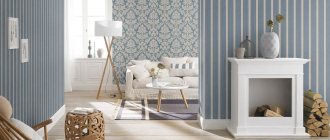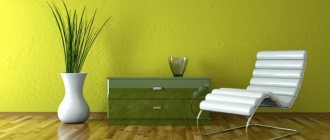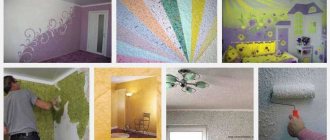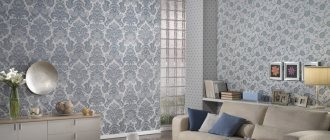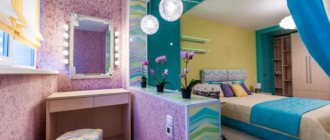Types and characteristics of fabric wallpaper
- Properties and characteristics of textile wallpaper
- Kinds
- Linen fabric
- Jute textile wallpaper
- Silk wallpaper
- Jacquard
- Cotton fabric wallpaper
- Velor
- Textile wallpaper on paper basis
- Felt
- Wallpaper made from synthetic materials
- Non-woven textile wallpaper
- Advantages and disadvantages of fabric wallpaper
- Flaws
- Recommendations for selection
- How to glue - some tips
No matter how surprising it may sound, fabric textile wallpapers marked their appearance long before traditional paper counterparts, and even more so non-woven fabrics. But their use in the form we are already familiar with became popular only a couple of decades ago. Today, textile wallpaper is an essential component of a spectacular and luxurious interior.
Pros and cons of textiles
Despite its popularity, this type of finishing material is used less often than ordinary wallpaper or decorative plaster. But in vain, since textile material has many positive qualities.
The advantage of textiles over paper and other coatings
- Provide good sound insulation of the room (felt, corduroy).
- Do not fade thanks to special protective coatings.
- They create additional thermal insulation of the room in which they are used (felt).
- The comfort that a room decorated with fabric wallpaper receives cannot be compared with anything.
A room covered with textile wallpaper always creates a feeling of comfort - An extraordinary variety of colors, shades, textures.
- Environmentally friendly material.
Disadvantages of textiles
This material has few disadvantages, but they are significant. And when deciding which textile wallpaper to choose, you should pay attention to them in order to make the right choice and not purchase material that is irrelevant for your room.
Firstly, you can’t stick them anywhere – they are not suitable for a bath or kitchen for several reasons:
- They “remember” smells very well.
- They are afraid of water and cannot stand wet cleaning. True, there are durable samples, but the price does not allow them to be used anywhere, especially since there are cheaper options.
Secondly, they are not suitable for every room:
- Very easily soiled and easily damaged. If a cat or dog lives in an apartment or house, such wallpaper is prohibited. If you have a small child, this option is also not for you.
- Dust accumulates on the surface. You can remove it with a vacuum cleaner or a slightly damp cloth. Many representatives of textile wallpaper are treated with a special antistatic impregnation; it repels dust for some time. However, its effect weakens over time.
Textile wallpaper is not intended for wet cleaning
Thirdly, despite the ease of installation, care in working with them will not hurt:
- You need to be extremely careful during installation. If glue accidentally gets on the outer surface, it will be impossible to wash off the resulting stain. We are talking about paper-based wallpaper, since they are glued to the surface like usual - first the back part is smeared with glue, then they are placed on the wall and smoothed out.
Fourthly, the cost of such beauty is not affordable for everyone. Plus, the denser and better quality the fabric, the more expensive the material.
Video about the features of textile wallpaper:
Types of fabric wallpaper
Depending on the manufacturing technology, fabric wallpaper for walls is divided into: silk, linen, felt and jute.
Silk
The canvases, despite their names, are not entirely made of silk. The main material in production is viscose. Thanks to this, the coating has a number of positive properties: it is resistant to direct sunlight, has a long service life and a unique decorative design.
This product is the most expensive of all fabric wallpapers. Silk products are sewn only to order using the individual preferences of the customer.
Linen
They are paper fibers with a combination of flax fibers. This option is the cheapest and most popular of the entire line of products. To increase the service life of the coating, many manufacturers add various compounds that increase the strength and light resistance of the coating.
Felt
They have the most pleasant-to-touch coating. This is explained by the fact that felt fabric is added to the base during production. In its appearance and properties it is very similar to velor.
Jute
They are characterized by being made from wood fiber. Jute wallpaper on a fabric base goes well with a rustic and “natural” style in the interior. Among the technical characteristics, they include: density and strength, ease of gluing and the ability to visually hide irregularities.
Types of textile wallpaper
Depending on what fabric was used in the production of textile wallpaper, several classes are distinguished. So, let's look at the characteristics of the main ones.
Linen wallpaper
This is a classic option among textile wallpapers, and the most inexpensive. The finished surface is obtained by lamination with mixed threads. The result is a surface with sometimes slightly different shades of threads, but this gives it naturalness and the effect that the walls are covered with fabric.
Linen wallpaper has good performance properties: a high degree of heat and sound insulation, immunity to sunlight, and a lower ability to attract dust than others. They are great for children's rooms, offices and other rooms with normal humidity levels.
Silk wallpaper
Despite the name, only part of silk wallpaper is made of silk, the rest is viscose, which allows the material to be significantly cheaper. The finished surface is, frankly speaking, luxurious. Such wallpapers are widely used in bedrooms and offices made in Provence or Empire style.
As for the properties, they all remain the same as the general properties for textile wallpaper.
Jute wallpaper
Jute is an Indian plant that is used to make fabric and rope and is distinctive in appearance and has a wonderful texture. So the wallpaper turns out to have a pronounced texture, and you can easily hide small imperfections in the walls with it, and some types can also be painted in the desired color.
Jute wallpaper is not the most demanding and difficult to maintain among all textile wallpapers, so it will not cause major problems. This material will perfectly complement an interior in a country or eco style; moreover, it does not fade and has good wear resistance.
Felt wallpaper
One of the most preferred types of textile wallpaper in terms of characteristics: they practically do not fade, they retain sound and heat well. They are made by applying felt or its synthetic analogue to a paper base - most often, it is propylene. Of course, if you use an unnatural material, then the environmental friendliness decreases, but the price becomes more acceptable, and it will also be easier to maintain - such wallpaper can even be washed, for example, with a vacuum cleaner.
In any case, felt wallpaper looks decent on the wall - the feeling of being covered with a single piece of fabric. In general, felt wallpaper looks very much like velor, but since it strongly collects odors, it is suitable for rooms that do not have them: bedroom, living room, etc.
Velor wallpaper
The production of velor wallpaper is one of the most technologically advanced. Here the paper base is first coated with polyvinyl chloride paint, onto which a pattern is applied with a special adhesive paint. And until all this has dried, the canvas passes through a special installation that sprays textile particles, and due to the electrostatic attraction characteristic of this material, they settle on the base in a vertical position. Then the resulting canvas is dried and a material is obtained that completely imitates expensive fabrics, reminiscent of tapestry, velvet, etc.
The result is a very beautiful and unusual, especially when illuminated, coating, which, by the way, does not have a particularly low price. The stunning appearance of velor wallpaper, unfortunately, is not supported by equally excellent performance properties: they are very poorly protected from mechanical influences, and caring for them is quite problematic. Therefore, it is better to use them only in the bedroom, and then only with very careful care, otherwise they will soon lose all their external characteristics.
Synthetic based
The difference between synthetic-based wallpaper and the others listed above is that it uses paralon as a base, which ensures a high level of sound and heat insulation. In addition, such material is not only soft to the touch, but also elastic, and the price is much lower than everything that was considered before.
But still, the main advantage of such wallpaper is that you do not need to carefully prepare the surface, since due to their thickness they hide both unevenness and even some curvature of the walls.
Jacquard wallpaper
Jacquard wallpaper is a whole class of textile wallpaper, numbering about 250 items. Their height is quite non-standard - about 270 cm, which allows you to literally wrap the entire room in fabric in several stages, and this will reduce the number of seams to a minimum. In addition, in the production of jacquard wallpaper, a special base is used, which prevents the glue from being saturated, penetrating into the wallpaper layer and spoiling the pattern.
Wallpaper "Japanese grass"
The most unusual textile wallpaper, which is obtained by gluing fiberglass threads onto a paper base. Sometimes sage is used instead of fiberglass, so production is quite complex, the material is expensive, and the circle of potential buyers is small.
In addition, if in linen wallpaper a slightly different shade can be found in different canvases, then there may be differences in one roll - this is not a defect, but if it bothers you, then you should just adjust it and combine some parts with others.
As for gluing them, it is quite complicated, and in this case it is definitely better to entrust it to specialists, since the canvases are very thin and difficult to work with. By the way, thin canvases will not hide imperfections in the surface, so it must be perfect.
Advantages and disadvantages of textile wallpaper
It’s not difficult to understand the positive side of textile wallpaper - it’s a unique look, the naturalness of the materials, a respectable appearance, a long service life, and other advantages of the fabric used for their manufacture. But, as they say, you are greeted by your clothes, but seen off by your mind; it is not enough to know the advantages - in order to form the right impression of the material, you also need to become familiar with the shortcomings, of which textile wallpaper has many. These include the following disadvantages.
- The cost is too high - a couple of orders of magnitude higher than the most expensive ordinary wallpaper.
- They do not tolerate moisture. On some textile wallpapers, water stains remain permanent.
- Highly susceptible to dust. If ordinary wallpaper in this regard does not need to be looked after at all, then textiles will have to be vacuumed regularly. There are, of course, antistatic textile wallpapers, but they are even more expensive than regular material of this type.
- Complex gluing technology - a drop of glue, absorbed into the fabric, remains there almost forever in the form of an unsightly stain. Even the special glue recommended by the manufacturer does not help - care and caution are needed here!
In most cases, the disadvantages of these wallpapers outweigh their advantages, and people who have already encountered such wallpapers try not to use them in the future. The most they dare to do is make small decorative inserts. Also, this type of wallpaper is preferred by wealthy people - they don’t care how much they cost, and by and large, it is not they who take care of them, but hired workers. In general, you should think carefully about their use and talk to people who have already dealt with these wallpapers.
Advantages of textured wallpaper
Perhaps the greatest advantage of textile wallpaper is its versatility, which allows it to be used for finishing rooms of various types. Of no small importance is the fact that when using them, the joints on the walls are almost invisible, and any unevenness in the walls is completely hidden.
Textile wallpapers are made mainly from natural materials, which eliminates the risk of allergic reactions. They do not accumulate dampness, and therefore a room covered with fabric wallpaper will always be dry. The naturalness of the raw materials used in the manufacture of such wallpaper determines their heat-saving effect. Depending on the material used, this type of wallpaper may have disinfecting and soundproofing properties.
textile wallpaper in the interior
When to use fabric wallpaper for walls
This type of coating is suitable for design in bedrooms, children's rooms, offices, living rooms and dining rooms.
It is worth giving preference to this particular finishing coating if the interior predisposes to an atmosphere of luxury or, on the contrary, maximum eco-friendly orientation. Also an ideal solution when it is necessary to hide uneven walls - textured felt, jute or velor wallpaper.
Another important factor is environmental friendliness, for example, for children's rooms it is better to choose natural materials.
Where is it appropriate to use textile wallpaper?
There are not many places in the house where it is permissible to decorate a wall with textile wallpaper. First of all, we exclude the bathroom, kitchen and corridor, since fabric finishing does not tolerate moisture, temperature changes, dirt and strong odors.
Textile wallpaper in a children's room is a dubious decision. On the one hand, they are safe and create a comfortable, cozy atmosphere, but on the other hand, they get dirty easily and cannot be washed.
If you take them for a child, then it is best to stop at felt ones, which are still a little amenable to cleaning, but do not buy velor or linen ones.
The rooms where textile wallpaper will be in its place are the living room, bedroom and office. In these rooms the environment is more moderate. It seems to me that silk wallpaper looks especially impressive in the office and living room, and simple fabrics such as linen and jute are great for the bedroom.
Textile wallpaper on a foam rubber basis is relevant for rooms with high noise levels - they are offered on the Internet for “home cinemas”. Or, for example, it would be nice to decorate one of the rooms like this if there are children in the house who go to bed early.
What drawing?
Traditional.
Fabric wallpaper is a classic, and the patterns on it are traditional. These are floral patterns, rosettes, medallions, simple “geometry” (stripes, squares), and plain coverings.
- 1 of 4
On the picture:
Collections that include wallpapers of different textures and colors, which can be combined to suit your own taste, will help diversify your interior.
A few words about gluing
The characteristic points for gluing walls with fabric-based wallpaper are as follows:
- For all types of fabric wall coverings, binders suitable for heavy wallpaper are used;
- Fabric sheets soaked in glue are applied to the wall using a special brush with soft and long bristles;
- In the case of gluing felt canvases, the glue is applied only to the walls, without the need to apply it to the finishing material itself;
- All textile coverings are glued together joint to joint;
- Try to avoid creases when gluing linen and silk wallpaper.
In many characteristics and nuances, gluing fabric wallpaper is no different from covering walls with paper or non-woven fabric.
The process of gluing with fabric is carried out according to standard technology, which involves leveling the base, applying protective compounds, marking the walls, cutting the canvas, diluting the glue and, in fact, gluing itself.
Thus, applying fabric covering to walls is quite easy. What is important is to precisely compress the canvas and be careful.
Expert recommendations for wallpapering and care
In order not to spoil the expensive finishing material and enjoy all the advantages of seamless wallpaper, you need to follow several expert recommendations for gluing textile fabric and caring for it. First of all, it is necessary that the walls and corners are perfectly smooth, and then it will be possible to achieve symmetry of the pattern. It is recommended to start gluing from the far corner or the place where high furniture will be installed (wall, closet, etc.). To smooth the canvas on the wall surface, use a rubber roller; to work in corners, use a flexible silicone wallpaper spatula. If bubbles form, you can use a hot iron set to the “cotton” setting to smooth it out.
Smooth out the wallpaper with a special flexible spatula
For long-term service of seamless wallpaper, it is necessary to treat it with care and provide proper and constant care. By the way, caring for this finishing material is quite easy, since manufacturers treat the front part of the wallpaper with special antistatic compounds that create reliable protection against dust and dirt. However, this type of finish should not be wet cleaned and detergents should not be used. You can clean dirt with a vacuum cleaner or a slightly damp cloth.
Textile seamless wallpaper accepts dry cleaning only
